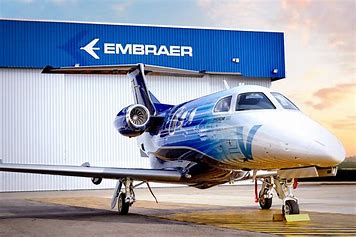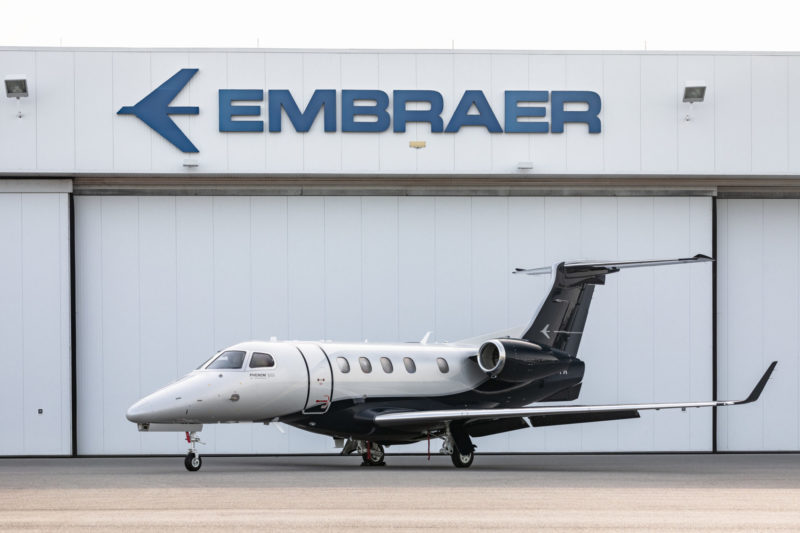Shares traded the highest volume on B3 stock exchange, surpassing Itaú, Vale
02/06/2025
Embraer announced to the market on Wednesday (5) that it has signed an agreement with Flexjet—a U.S.-based company focused on leasing and sharing private aircraft—to sell 182 executive jets, along with 30 options. The deal is valued at $7 billion.
The agreement was well-received by the market, causing the Brazilian plane maker shares to soar by 15.51% at the close, reaching R$66.37 and marking the highest increase on the benchmark stock index Ibovespa.
Reflecting the news, the financial volume traded in Embraer shares was the largest on the trading floor, totaling R$1.377 billion, surpassing stock market giants Itaú (with R$1.246 billion), Vale (R$1 billion), and Petrobras (R$621 million), according to data from Valor Pro, Valor’s real-time information service.
According to Embraer, the agreement includes a fleet comprising the Praetor 600, Praetor 500, and Phenom 300E models, plus a services and support package. This is the largest order by Flexjet in its 30-year history and also the largest firm order for the Brazilian manufacturer’s executive jets.
“We are very happy with Flexjet’s renewed commitment to Embraer through this comprehensive purchase agreement, which further strengthens our over 20-year strategic partnership,” said Michael Amalfitano, president and CEO of Embraer Executive Jets, in a statement.
The partnership between Embraer and Flexjet began in 2003 when Flight Options, which became part of the Flexjet group in 2015, was the first shared ownership company to introduce the Brazilian Legacy Executive jet into its fleet.
The deal marks another strong bet from a major group in the Brazilian company. In March 2024, Embraer once again surprised the market by announcing an order of 133 E175 jets (including firm orders and purchase rights) by American Airlines. That agreement also exceeded $7 billion, considering the list price.
American Airlines, one of the largest airlines in the world, has become an important name in the global market betting on Embraer’s aircraft. On the commercial side, the Brazilian company has benefited from a post-pandemic trend of airlines seeking smaller planes, which are easier to fill.
The Embraer E1 has been successful in the United States, given access to the regional market. A union agreement limits the weight of jets in regional operation to 39 tonnes, which is why the E2, as it is a larger model, does not occupy that space.
Embraer ended 2024 with 73 aircraft delivered by its commercial division, a 14% increase year-over-year. In the executive segment, deliveries totaled 130, a 13% increase on the same basis.
The company still has an opportunity to grow its commercial division, which has been operating below the 100 annual deliveries mark for several years due to a weak supply chain. The company has indicated to the market that by 2026, depending on its suppliers’ capabilities, it expects to return to that level.
Despite the challenges, the Brazilian manufacturer has fared better compared to giants Boeing and Airbus, which operate larger aircraft and whose technology has posed complex challenges, particularly with more frequent engine maintenance on newer models.
Due to these maintenances, the industry has struggled with a shortage of engines, causing aircraft to be grounded worldwide. Embraer, by operating smaller jets with less drag (the more drag, the higher the fuel consumption, and the more force the engine must exert), requires maintenance at a greater interval.
In a report, the Itaú BBA team said Embraer’s announcement confirms that its executive aviation unit is among the company’s main growth drivers this year. According to analysts Daniel Gasparete, Gabriel Rezende, and Pedro Tineo, the order validates the Brazilian company’s strong operational moment, practically doubling its order book. The bank calculates that the order will sustain the company’s EBITDA growth by at least 10% per year until 2028, creating the potential for an upside in stock return estimates.
The Citi team noted that the announcement means a significant bet in the company regarding the quality of its products and the safety of its operations. Analysts Stephen Trent, Filipe Nielsen, and André Mazini wrote that even if the order has some discount due to its large volume, it considerably expands Embraer’s order book.
The XP team wrote that the deal confirms long-term delivery prospects following the current capacity expansion. Analysts Lucas Laghi, Fernanda Urbano, and Guilherme Nippes added that the addition of $7 billion to the order book ensures revenue visibility for the next five years.
“While we maintain our estimates unchanged, we believe that this order not only ensures longer revenue visibility but also reduces the delivery growth risk in the coming years,” XP pointed out.
- By Cristian Favaro, Bruna Furlani e Felipe Laurence — São Paulo
- Source: Valor International
- https://valorinternational.globo.com/

/i.s3.glbimg.com/v1/AUTH_37554604729d4b2f9f3eb9ad8a691345/internal_photos/bs/2024/4/q/AKF6ErTYm76ZDOvUBjCw/embraer-20c-390-20assembly-20line-20-283-29.jpg)

/i.s3.glbimg.com/v1/AUTH_37554604729d4b2f9f3eb9ad8a691345/internal_photos/bs/2022/S/x/wh9hKBQJObd39oNb97oQ/24emp-100-embraer-b1-img01.jpg)
/i.s3.glbimg.com/v1/AUTH_37554604729d4b2f9f3eb9ad8a691345/internal_photos/bs/2022/B/W/7pnMoQTLCAdxL5G3hzJQ/embraer-celso-doni-valor.png)
/i.s3.glbimg.com/v1/AUTH_37554604729d4b2f9f3eb9ad8a691345/internal_photos/bs/2022/g/A/AxVbUPTVKgkw6X3AXbhQ/12emp-200-embraer-b4-img01.jpg)
/i.s3.glbimg.com/v1/AUTH_37554604729d4b2f9f3eb9ad8a691345/internal_photos/bs/2021/Z/s/Y6unYaRM6Jnm4JLLsBwQ/evtol-divulgacao.jpg)

